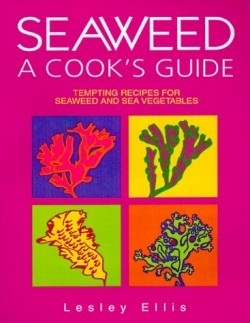Seaweed
Tempting Recipes for Samphire Seaweed and Sea Vegetables
In this country of fads and fascinations, a diet that includes seaweed or sea vegetables has been the exclusive territory of health fanatics and hippies. Ellis wants to banish this notion. She begins with a wonderfully informative history and outline of the ten most commonly consumed seaweeds. The reader finds that Hawaii, New Zealand, Britain, Ireland, Norway, Russia, the Mediterranean, France, Korea, Indonesia, Japan and China are just some of the cultures with a history of consuming sea vegetables.
Ellis introduces the reader to dulse harvested and eaten along the eastern seaboard of New England; laver better known as nori, the Japanese sushi-maki covering; carrageen, “a fan of delicate, frilly pink, purple and cream fronds” (she points out its use as a commercial gelling agent); and samphire a seaside succulent finding its way into gourmet circles. Surprise. It seems that the American public has been eating and will continue to eat the odd and oft-ridiculed seaweed.
As Ellis points out, sea vegetables are best served simply. She accomplishes this with recipes that have reasonable lists of ingredients and short procedures. Many dishes invite the reader to creative uses. In Seaweed-Baked Fish Steaks Ellis wraps halibut with soaked wakame and bakes it. In Roast Lamb with Rosemary and Laver Sauce Ellis prepares a sauce with a delicate nori puree, orange juice and pan drippings. Fresh Noodles Made with Seaweed are homemade pasta with nori flakes and a creamy fish sauce. Dulse Chips—dulse sauteed in butter—sound simply lovely.
Despite her knowledge and enthusiasm for her subject, Ellis? cooking instructions are sometimes spotty. Instead of giving a more accurate internal temperature for cooking the lamb, she tells the reader to roast it “20 to 25 minutes per pound plus 25 minutes depending on how pink you like your lamb.” In Sushi Rolls Ellis? directions for cooking the rice result in very wet rice unsuitable for sushi.
This informative and interesting cookbook may not appeal to all readers but the cook interested in sea vegetables will find a gentle and charming work. Ellis? cookbook will bring the American public a step closer to viewing seaweed as just another vegetable.
Reviewed by
Nancy K. Allen
Disclosure: This article is not an endorsement, but a review. The publisher of this book provided free copies of the book to have their book reviewed by a professional reviewer. No fee was paid by the publisher for this review. Foreword Reviews only recommends books that we love. Foreword Magazine, Inc. is disclosing this in accordance with the Federal Trade Commission’s 16 CFR, Part 255.

